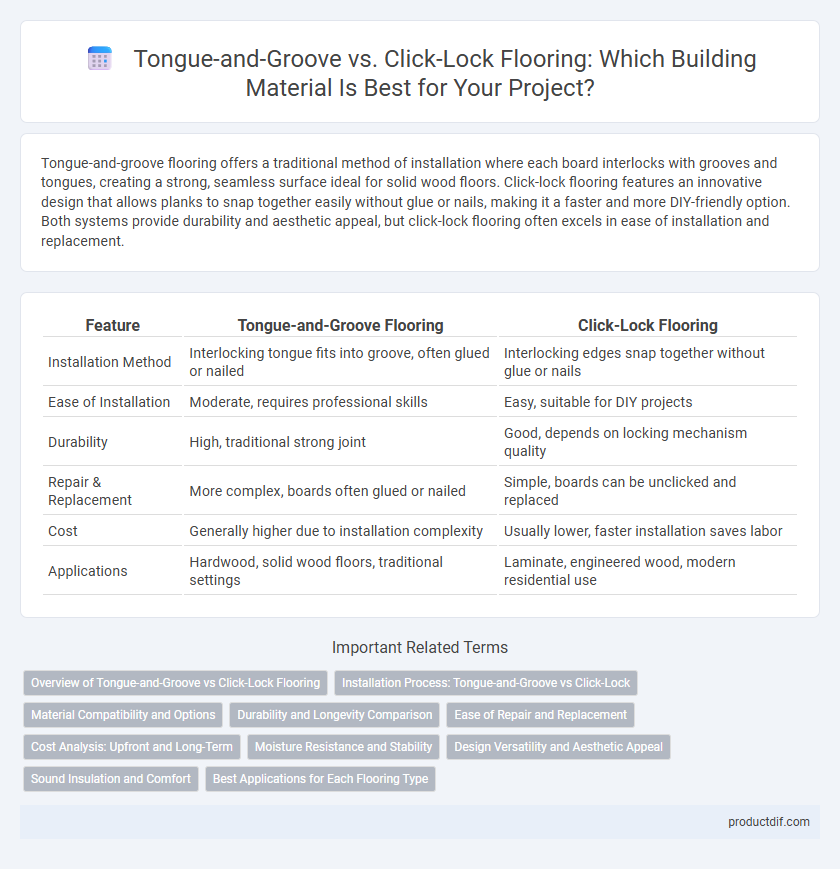Tongue-and-groove flooring offers a traditional method of installation where each board interlocks with grooves and tongues, creating a strong, seamless surface ideal for solid wood floors. Click-lock flooring features an innovative design that allows planks to snap together easily without glue or nails, making it a faster and more DIY-friendly option. Both systems provide durability and aesthetic appeal, but click-lock flooring often excels in ease of installation and replacement.
Table of Comparison
| Feature | Tongue-and-Groove Flooring | Click-Lock Flooring |
|---|---|---|
| Installation Method | Interlocking tongue fits into groove, often glued or nailed | Interlocking edges snap together without glue or nails |
| Ease of Installation | Moderate, requires professional skills | Easy, suitable for DIY projects |
| Durability | High, traditional strong joint | Good, depends on locking mechanism quality |
| Repair & Replacement | More complex, boards often glued or nailed | Simple, boards can be unclicked and replaced |
| Cost | Generally higher due to installation complexity | Usually lower, faster installation saves labor |
| Applications | Hardwood, solid wood floors, traditional settings | Laminate, engineered wood, modern residential use |
Overview of Tongue-and-Groove vs Click-Lock Flooring
Tongue-and-groove flooring features planks with a precise groove on one edge and a matching tongue on the other, creating a tight, stable fit when installed with nails or glue; this method offers enhanced durability and sound insulation. Click-lock flooring utilizes interlocking edges that snap together without adhesives or nails, allowing faster installation and easier replacement of damaged planks. Both systems support various materials like hardwood, laminate, and vinyl, but tongue-and-groove is preferred for long-term structural integrity while click-lock maximizes user-friendly installation and maintenance.
Installation Process: Tongue-and-Groove vs Click-Lock
Tongue-and-groove flooring requires precise alignment and often involves nailing or gluing the boards to the subfloor, making the installation more labor-intensive and time-consuming. Click-lock flooring features a simple interlocking mechanism that allows planks to snap together quickly without nails or glue, significantly reducing installation time and skill requirements. Both methods offer strong flooring stability, but click-lock flooring is preferred for DIY projects due to its ease of installation.
Material Compatibility and Options
Tongue-and-groove flooring offers greater material compatibility, especially with solid hardwood and engineered wood, allowing for traditional installation methods. Click-lock flooring is predominantly designed for laminate, vinyl, and some engineered wood, providing easier installation but with limited material choices. Both flooring types support a variety of finishes, but tongue-and-groove is preferred for authentic wood options due to its durable joint structure.
Durability and Longevity Comparison
Tongue-and-groove flooring offers superior durability due to its interlocking design, which provides a tighter fit and greater resistance to movement and moisture compared to click-lock flooring. The solid connection in tongue-and-groove installation reduces the likelihood of gaps and warping, enhancing the flooring's longevity. Click-lock systems, while easier to install, may experience more wear and separation over time under heavy use or fluctuating humidity.
Ease of Repair and Replacement
Tongue-and-groove flooring offers easier repairs as individual boards can be removed and replaced without disturbing the entire floor, making it ideal for localized fixes. Click-lock flooring, while simpler to install, often requires disassembling multiple planks to access and replace a damaged section, complicating repairs. For maintenance efficiency, tongue-and-groove floors provide superior ease of repair and replacement compared to click-lock systems.
Cost Analysis: Upfront and Long-Term
Tongue-and-groove flooring typically incurs higher upfront costs due to specialized milling and installation labor, while click-lock flooring offers a more budget-friendly initial investment with its DIY-friendly installation. Over the long term, tongue-and-groove tends to provide greater durability and stability, potentially reducing maintenance and replacement expenses. Homeowners seeking cost efficiency often balance the lower initial price of click-lock with the longevity advantages of tongue-and-groove options.
Moisture Resistance and Stability
Tongue-and-groove flooring offers enhanced moisture resistance due to its interlocking edges that create a tighter seal, reducing water infiltration and swelling. Click-lock flooring, while easier to install, often has less effective moisture barriers at the joints, potentially leading to expansion and warping in high-humidity environments. Stability in tongue-and-groove flooring is generally superior, as the glued joints provide a firmer connection compared to the snap-fit mechanism of click-lock systems.
Design Versatility and Aesthetic Appeal
Tongue-and-groove flooring offers seamless joints that create a uniform, classic appearance ideal for traditional and rustic interior designs. Click-lock flooring provides greater design versatility with easy installation and a wide range of finishes, making it suitable for modern, eclectic spaces. Both options enhance aesthetic appeal, but click-lock systems allow for quicker style updates without compromising durability.
Sound Insulation and Comfort
Tongue-and-groove flooring offers superior sound insulation due to its interlocking joints, minimizing gaps that reduce noise transmission between rooms. Click-lock flooring provides easier installation but may require additional underlayment to achieve comparable acoustic comfort. Both types benefit from quality padding, yet tongue-and-groove systems generally deliver better overall sound dampening and a more stable, comfortable surface underfoot.
Best Applications for Each Flooring Type
Tongue-and-groove flooring is best suited for traditional wood floors in residential spaces where a seamless, permanent installation is desired, providing enhanced stability and durability. Click-lock flooring excels in DIY projects and rental properties due to its easy, floating installation method that allows for quick replacement and minimal subfloor preparation. Both flooring types offer distinct advantages depending on the need for long-term permanence versus flexibility and ease of installation.
Tongue-and-groove flooring vs Click-lock flooring Infographic

 productdif.com
productdif.com